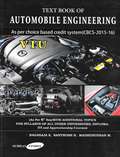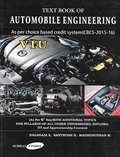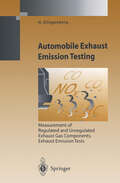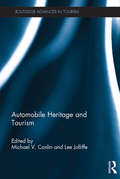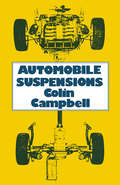- Table View
- List View
Automobile Engineering 6th Semester
by Nagaraja S Santhosh N Madhusudhan M.As per 6th Semester with additional Topics for syllabus of the other universities, Diploma, ITI and Apprenticeship courses.
Automobile Engineering for Sixth Semester Mechanical Engineering
by Nagaraja S Santhosh N Madhusudhan M.Automobile Engineering is a branch of study which teaches manufacturing, designing, mechanical mechanisms as well as the specific operations of automobiles. It is an introduction to vehicle engineering which deals with motorcycles, cars, buses trucks etc. It includes domain specific knowledge of mechanical, electronic, software and safety elements.The text book contains neat sketches and salient points to help students and readers understand the principles of automobile engineering. The theoretical questions are included at the end of each module to make the book a complete unit in all aspects.
Automobile Erlebniswelten als Kommunikationsmittel: Eine verhaltenswissenschaftliche Analyse am Beispiel des Premiummarktes in Deutschland und Singapur (Europäische Kulturen in der Wirtschaftskommunikation)
by Franziska MassenbachAutomobile Exhaust Emission Testing: Measurement of Regulated and Unregulated Exhaust Gas Components, Exhaust Emission Tests (Environmental Science and Engineering)
by H. KlingenbergDiffering legislation between the countries or unions of countries involved in pollution reduction has turned gas measuring technology into such an extremely extensive and complex field that only a few specialists in environmental agencies and the automobile industry have a grasp of it. This book is intended as an overview of the basics of exhaust gas measuring technology describing the interrelation between emissions, immissions and the effects of pollutants. It aims to provide experts and students alike with an understanding of the interrelationships and details within this field. The results presented are based on the experience gathered by the author during work spanning more than two decades in the automobile industry.
Automobile Heritage and Tourism (Routledge Advances in Tourism)
by Michael V. Conlin Lee JolliffeAutomobile heritage encompasses a complex range of artefacts and activities. Beyond just historic vehicles which are the primary artefacts of this niche, it also includes communities of collectors and enthusiasts, private owners and public institutions, as well as historic motoring environments, literally thousands of museums, exhibitions and car shows throughout the world, and a range of paraphernalia that includes both original and replicated promotional materials, equipment and parts, and guide books. Although automobile heritage has been the subject of some limited research, Automobile Heritage and Tourism is unique in examining its scope and role within tourism. The book looks at a vast array of topics, from the experience of using and collecting old cars, related destination development, automobile heritage and museums, to events such as vintage automobile racing, promotion and social change. It thereby provides a thorough review of the impacts of automobile heritage on tourism. A number of theories provide a framework and are analysed throughout, including those related to the collection, display, exhibition and use of historic automobiles. The title takes a global and interdisciplinary view of the subject with international contributions from both established and emerging scholars in the field.This book adds to the industrial heritage tourism literature and will appeal to a diverse audience, in particular those in the fields of cultural heritage and industrial heritage tourism, but also practitioners involved with the planning, restoration, exhibition and management of automobile heritage attractions and events.
Automobile Heritage and Tourism (Routledge Advances in Tourism)
by Michael V. Conlin Lee JolliffeAutomobile heritage encompasses a complex range of artefacts and activities. Beyond just historic vehicles which are the primary artefacts of this niche, it also includes communities of collectors and enthusiasts, private owners and public institutions, as well as historic motoring environments, literally thousands of museums, exhibitions and car shows throughout the world, and a range of paraphernalia that includes both original and replicated promotional materials, equipment and parts, and guide books. Although automobile heritage has been the subject of some limited research, Automobile Heritage and Tourism is unique in examining its scope and role within tourism. The book looks at a vast array of topics, from the experience of using and collecting old cars, related destination development, automobile heritage and museums, to events such as vintage automobile racing, promotion and social change. It thereby provides a thorough review of the impacts of automobile heritage on tourism. A number of theories provide a framework and are analysed throughout, including those related to the collection, display, exhibition and use of historic automobiles. The title takes a global and interdisciplinary view of the subject with international contributions from both established and emerging scholars in the field.This book adds to the industrial heritage tourism literature and will appeal to a diverse audience, in particular those in the fields of cultural heritage and industrial heritage tourism, but also practitioners involved with the planning, restoration, exhibition and management of automobile heritage attractions and events.
The Automobile in American History and Culture: A Reference Guide (American Popular Culture)
by Michael L. BergerThis comprehensive reference guide reviews the literature concerning the impact of the automobile on American social, economic, and political history. Covering the complete history of the automobile to date, twelve chapters of bibliographic essays describe the important works in a series of related topics and provide broad thematic contexts. This work includes general histories of the automobile, the industry it spawned and labor-management relations, as well as biographies of famous automotive personalities. Focusing on books concerned with various social aspects, chapters discuss such issues as the car's influence on family life, youth, women, the elderly, minorities, literature, and leisure and recreation. Berger has also included works that investigate the government's role in aiding and regulating the automobile, with sections on roads and highways, safety, and pollution. The guide concludes with an overview of reference works and periodicals in the field and a description of selected research collections.The Automobile in American History and Culture provides a resource with which to examine the entire field and its structure. Popular culture scholars and enthusiasts involved in automotive research will appreciate the extensive scope of this reference. Cross-referenced throughout, it will serve as a valuable research tool.
Automobile Industry Supply Chain in Thailand (SpringerBriefs in Economics)
by Munehiko Itoh Atsumi Kato Yoshitaka Shimono Yasuhiko Haraguchi Park TaehoonThis research focuses on the process of growth in the automobile industries in the ASEAN region. ASEAN is drawing attention both from the vantage point of its position as an automobile-producing region and as a potential automobile market. Thailand in particular has long treated automobile production as a national strategy, and this research puts considerable focus on Thailand's initiatives. Since 2012, the authors have been carrying out on-site surveys and have visited many of the suppliers that form the local automobile industry; this published research represents a summary of those findings. The fields of specialty of this study’s respective authors differ, so analyses have been made from a range of vectors. In particular, the focus is on the supply chain in what is generally referred to as a keiretsu.
Automobile Insurance: Actuarial Models (Huebner International Series on Risk, Insurance and Economic Security #4)
by Jean LemaireThe mathematical theory of non-life insurance developed much later than the theory of life insurance. The problems that occur in the former field are far more intricate for several reasons: 1. In the field oflife insurance, the company usually has to pay a claim on the policy only once: the insured dies or the policy matures only once. It is with only a few particular types of policy (for instance, sickness insurance, when the insured starts working again after a period of sickness) that a valid claim can be made on a number of different occasions. On the other hand, the general rule in non-life insurance is that the policyholder is liable to be the victim of several losses (in automobile insurance, of course, but also in burglary and fire insurance, householders' comprehensive insurance, and so on). 2. In the field of life insurance, the amount to be paid by the company excluding any bonuses-is determined at the inception of the policy. For the various types of life insurance contracts, the sum payable on death or at maturity of the policy is known in advance. In the field of non-life insurance, the amount of a loss is a random variable: the cost of an automobile crash, the partial or totalloss of a building as a result of fire, the number and nature of injuries, and so forth.
Automobile Insurance: Road Safety, New Drivers, Risks, Insurance Fraud and Regulation (Huebner International Series on Risk, Insurance and Economic Security #20)
by Georges Dionne Claire Laberge-NadeauMotor vehicle accidents are still a leading cause of death, even if the trend has somewhat declined over the past 20 years. Indeed, motor vehicle accidents are a significant cause of death in comparison with air and space transport accidents, homicides and even HIV infections, causes which are more often highlighted in the media. As shown in this book, motor vehicle accidents are particularly damaging to very young drivers. The assessment of driving risks is a common concern for road transportation safety and the automobile insurance industry. In both cases, there is an awareness of the great losses resulting from the deaths, injuries and property damage caused by traffic accidents. Research is essential to counteract this public health threat, to assess the success or failure of countermeasures, and to solve the problems it generates in the insurance industry. This book is for people concerned about road crashes (prevention and compensation) and about the insurance problems they pose - namely private and public institutional authorities, consultants, administrators, practitioners, and researchers interested in sharing the authors' experience in this domain. The book presents original contributions related to motor vehicle insurance and road safety. All papers have been evaluated by external referees. Four subjects are covered: 1) Automobile Insurance Pricing, Risks and Asymmetric Information; 2) Insurance Fraud; 3) Young Drivers: Licensing Policies, Evaluation and Risks; and 4) Road Insurance Regulation.
Automobile Mechanical and Electrical Systems
by Tom DentonThe second edition of Automobile Mechanical and Electrical Systems concentrates on core technologies to provide the essential information required to understand how different vehicle systems work. It gives a complete overview of the components and workings of a vehicle from the engine through to the chassis and electronics. It also explains the necessary tools and equipment needed in effective car maintenance and repair, and relevant safety procedures are included throughout. Designed to make learning easier, this book contains: Photographs, flow charts and quick reference tables Detailed diagrams and clear descriptions that simplify the more complicated topics and aid revision Useful features throughout, including definitions, key facts and ‘safety first’ considerations. In full colour and with support materials from the author’s website (www.automotive-technology.org), this is the guide no student enrolled on an automotive maintenance and repair course should be without.
Automobile Mechanical and Electrical Systems: Automotive Technology - Vehicle Maintenance And Repair
by Tom DentonThe second edition of Automobile Mechanical and Electrical Systems concentrates on core technologies to provide the essential information required to understand how different vehicle systems work. It gives a complete overview of the components and workings of a vehicle from the engine through to the chassis and electronics. It also explains the necessary tools and equipment needed in effective car maintenance and repair, and relevant safety procedures are included throughout. Designed to make learning easier, this book contains: Photographs, flow charts and quick reference tables Detailed diagrams and clear descriptions that simplify the more complicated topics and aid revision Useful features throughout, including definitions, key facts and ‘safety first’ considerations. In full colour and with support materials from the author’s website (www.automotive-technology.org), this is the guide no student enrolled on an automotive maintenance and repair course should be without.
Automobile Mechanical and Electrical Systems
by Tom Denton Hayley PellsThe third edition of Automobile Mechanical and Electrical Systems concentrates on core technologies to provide the essential information required to understand how different vehicle systems work. It gives a complete overview of the components and workings of a vehicle from the engine through to the chassis and electronics. It also explains the necessary tools and equipment needed in effective car maintenance and repair, and relevant safety procedures are included throughout. Designed to make learning easier, this book contains: Photographs, flow charts and quick reference tables Detailed diagrams and clear descriptions that simplify the more complicated topics and aid revision Useful features throughout, including definitions, key facts and ‘safety first’ considerations. In full colour and with support materials from the author’s website (www.automotive-technology.org), this is the guide no student enrolled on an automotive maintenance and repair course should be without.
Automobile Mechanical and Electrical Systems
by Tom Denton Hayley PellsThe third edition of Automobile Mechanical and Electrical Systems concentrates on core technologies to provide the essential information required to understand how different vehicle systems work. It gives a complete overview of the components and workings of a vehicle from the engine through to the chassis and electronics. It also explains the necessary tools and equipment needed in effective car maintenance and repair, and relevant safety procedures are included throughout. Designed to make learning easier, this book contains: Photographs, flow charts and quick reference tables Detailed diagrams and clear descriptions that simplify the more complicated topics and aid revision Useful features throughout, including definitions, key facts and ‘safety first’ considerations. In full colour and with support materials from the author’s website (www.automotive-technology.org), this is the guide no student enrolled on an automotive maintenance and repair course should be without.
The Automobile Revolution: Towards a New Electro-Mobility Paradigm
by Danielle AttiasThis book discusses cars of the future and the new socio-economic paradigm that they represent. It examines the electromobility revolution in the traditional automotive industry and brings together multidisciplinary expertise to provide insights into the shift towards electromobility. New vehicular technologies may develop in various directions, including the smart car, and this context raises two important questions: will car manufactures maintain control over the industry? And if so, will they be able to come up with sufficiently radical innovations to steer us into the electromobility of tomorrow? One thing is certain: the transition to electromobility will be a revolution. The book’s combined approach to understanding this complex reality enables readers to better visualize the possible future directions. It offers anyone interested in electromobility an excellent review of the subject and a useful roadmap to future developments.
Automobile Suspensions
by Colin CampbellThis book is an introduction to the elementary technology of automobile suspensions. Inevitably steering geometry must be included in the text, since the dynamic steering behaviour, road-holding and cornering behaviour are all influenced by the suspension design. Steering mechanisms and steering components are not covered in this book. This is not a mathematical treatise, but only a fool or a genius would attempt to design a motor vehicle without mathematics. The mathematics used in this book should present no problem to a first-year university student. SI units have been used in general, but for the benefit of those not familiar with them we have included in brackets, in many cases, the equivalent values in Imperial units. Many engineers regard the Pascal as an impractical unit of pressure. The author has therefore expressed pressures in bars (1 bar = 105Pa). A deviation from SI units is the use of degrees and minutes, instead of radians, to express camber, castor, roll angles, etc. This is still common practice in the motor industry. No attempt has been made to make any stress calculations on suspension components. The automobile engineering student will have access to other textbooks on such subjects as strength of materials and theory of structures.
Automobilelektronik: Eine Einführung für Ingenieure (ATZ/MTZ-Fachbuch)
by Konrad ReifAutomobilelektronik eignet sich bestens für das Studium und enthält eine aktuelle Einführung in elektrische und elektronische Systeme im Automobil einschließlich Bussystemen, Sensorik und Software. Es folgen Kapitel zu wichtigen elektronischen Systemen im Automobil, wie z.B. Motor- und Getriebesteuerung, Fahrerassistenz- und Sicherheitssystemen. Ebenso sind Themen wie Bordnetz, Energieversorgung und Kfz-Lichttechnik enthalten. In der neuen Auflage wird das Kapitel Diagnose ergänzt und erweitert.
Automobilelektronik: Eine Einführung für Ingenieure (ATZ/MTZ-Fachbuch)
by Konrad ReifExperten aus Automobilindustrie und Hochschulen liefern mit dem Band eine topaktuelle und praxisnahe Einführung in elektrische und elektronische Systeme im Automobil. Nach den Grundlagen der Sensorik, von Bussystemen, Betriebssystemen und der Softwareentwicklung werden elektronische Systeme im Automobil behandelt. Dazu zählen u. a. Motor- und Getriebesteuerung, Energieversorgung, Sicherheits- sowie Navigations- und Fahrerassistenzsysteme. Für die 4. Auflage wurde das Kapitel über Fahrerassistenzsysteme grundlegend überarbeitet und erweitert.
Automobilelektronik: Eine Einführung für Ingenieure (ATZ/MTZ-Fachbuch)
by Konrad ReifAutomobilelektronik eignet sich bestens für das Studium und enthält eine topaktuelle Einführung in elektrische und elektronische Systeme im Automobil einschließlich Bussystemen, Sensorik und Software. Es folgen Kapitel zu wichtigen elektronischen Systemen im Automobil, wie z.B. Motor- und Getriebesteuerung, Fahrerassistenz- und Sicherheitssystemen. Ebenso sind Themen wie Bordnetz, Energieversorgung und Kfz-Lichttechnik enthalten. Das Lehrbuch wurde überarbeitet und gegenüber der 1. Auflage um das Kapitel Echtzeitbetriebssysteme erweitert.
Automobilelektronik: Eine Einführung für Ingenieure (ATZ/MTZ-Fachbuch)
by Konrad ReifAutomobilelektronik eignet sich bestens für das Studium und enthält eine topaktuelle Einführung in elektrische und elektronische Systeme im Automobil einschließlich Bussystemen, Sensorik und Software. Es folgen Kapitel zu wichtigen elektronischen Systemen im Automobil, wie z.B. Motor- und Getriebesteuerung, Fahrerassistenz- und Sicherheitssystemen. Ebenso sind Themen wie Bordnetz, Energieversorgung und Kfz-Lichttechnik enthalten.
Automobilergonomie (ATZ/MTZ-Fachbuch)
by Heiner Bubb Klaus Bengler Rainer E. Grünen Mark VollrathErgonomie lehrt, wie Technik so zu gestalten ist, dass sie optimal an die Bedürfnisse, Wünsche und Eigenschaften des Nutzers angepasst ist. Es hat sich in diesem Zusammenhang der Begriff vom Mensch-Maschine-System etabliert. Sachsystematisch und mit detailliertem Blick auf die komplizierten technischen und wahrnehmungspsychologischen und methodischen Zusammenhänge werden in diesem Buch die Grundlagen mit zahlreichen Beispielen erklärt. Dabei zeigt sich die Anwendung der Fahrzeugergonomie in den Beispielen wie Package, Gestaltung von Anzeigen und Bedienelementen, von Umweltergonomie wie Beleuchtung, Schall, Schwingungen, Klima und Geruch. Auch die Gestaltung von Fahrerassistenzsystemen aus ergonomischer Sicht ist ein zentrales Thema. Abgerundet wird das Buch durch Methoden der ergonomischen Fahrzeugentwicklung, die Nutzung von Mock-Ups, Fahrsimulatoren und von Versuchen in Realfahrzeugen und Prototypen. Erstmals wird den Verantwortlichen in der Automobilindustrie und im Bereich der einschlägigen Forschung ein fachsystematisches Werk an die Hand gegeben, das die ergonomischen Erkenntnisse bei der Gestaltung heutiger Automobile bereitstellt. Damit erhalten Planer und Konstrukteur heutiger Automobile konkrete Angaben für die ergonomische Produktentwicklung und können so entscheidende Anforderungen und die spätere Kundenakzeptanz im Blick behalten.
Automobiles and the Future: Competition, Cooperation, and Change (Michigan Papers in Japanese Studies #10)
by Robert E. ColeAt the time of the U.S.-Japan auto conferences in March 1983, the hoped-for economic recovery as manifested in auto sales had revealed itself quite modestly. Three months later, the indicators were more robust and certainly long overdue for those whose livelihood depends on the health of the industry--some of whom are university professors. With Japanese import restrictions in place until March 1984 and drastically reduced break-even points for domestic manufactures, rising consumer demand holds great promise for the industry. The rapidly rising stock prices of the auto-makers captures well the sense of heightened optimism, as do the various forecasts for improved profits. While the news is certainly welcome, it nevertheless should be greeted with caution. As Mr. Perkins noted at the conference, "we have a tendency to forget things very quickly. If we have a boom market this year, there is a good chance that a lot of things we learned will be forgotten." To put the matter differently and more bluntly, with growing prosperity there is the risk that management will fall back into old habits, making impossible the achievement of sustained quality and productivity improvement. Similarly, the commitment to develop cooperative relations with workers and suppliers will weaken. The union will be under membership pressure to retrieve concessions rather than to take the longer-term view. This longer-term view recognizes that "up-front increases" and adherence to existing work rules increasingly come at the sacrifice of future job security. Government policymakers will turn their attention away from the industry. This may not mean a great deal given how weakly focused their attentions has been during the last three years and how mixed and contradictory government auto policies have been for over a decade.
Automobilities (PDF)
by John Urry Mike Featherstone Nigel ThriftMobility - flows, movement and migration in social life - has emerged as a central area of sociological debate, yet one of its most dominant forms, automobility, has remained largely ignored. Edited by three leading social analysts, Automobilities presents one of the first and most wide-ranging examinations of the car and its promise of autonomy and mobility. Drawing on rich empirical detail, from ethnographies of office work on the motorway to the important of the car in French cultural theory, the contributions demonstrate just how significant have been the economic, technological, social and political consequences of a pervasive and accelerating culture of the car. A broad array of theories are put to work to illuminate this vast and yet neglected topic: strategy and tactics, complexity theory, performativity, actor network theory, film theory, material culture, theories of non-places, embodiment, sensuous geography/sociology, ethnomethodology and non-representational theory. This book will firmly establish automobilities as a key topic for theory and research. Automobilities represents a landmark text that will contribute to and provide a significant impetus for the emerging analysis of mobilities in contemporary societies.
Automobility and the City in Twentieth-Century Britain and Japan (SOAS Studies in Modern and Contemporary Japan)
by Simon Gunn Susan C. TownsendAutomobility and the City in Twentieth-Century Britain and Japan is the first book to consider how mass motorization reshaped cities in Japan and Britain during the 20th century. Taking two leading 'motor cities', Nagoya and Birmingham, as their principal subjects, Simon Gunn and Susan C. Townsend show how cars changed the spatial form and individual experience of the modern city and reveal the similarities and differences between Japan and Britain in adapting to the 'motor age'. The book has three main themes: the place of automobility in post-war urban reconstruction; the emerging conflict between the promise of mobility and personal freedom offered by the car and its consequences for the urban environment (the M/E dilemma); and the extent to which the Anglo-Japanese comparison can throw light on fundamental differences in cultural understanding of the environment, urbanism and the self. The result is the first comparative history of mass automobility and its environmental consequences between East and West.
